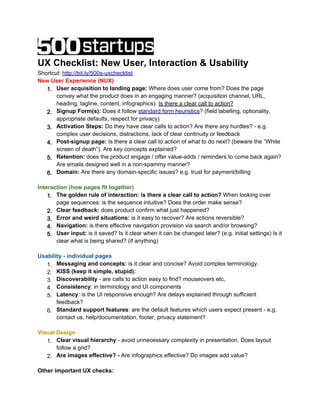Checklistux interaction flowandusability
- 1. UX Checklist: New User, Interaction & Usability Shortcut: http://bit.ly/500s-uxchecklist New User Experience (NUX) 1. User acquisition to landing page: Where does user come from? Does the page convey what the product does in an engaging manner? (acquisition channel, URL, heading, tagline, content, infographics). Is there a clear call to action? 2. Signup Form(s): Does it follow standard form heuristics? (field labelling, optionality, appropriate defaults, respect for privacy) 3. Activation Steps: Do they have clear calls to action? Are there any hurdles? - e.g. complex user decisions, distractions, lack of clear continuity or feedback 4. Post-signup page: Is there a clear call to action of what to do next? (beware the ŌĆ£White screen of deathŌĆØ). Are key concepts explained? 5. Retention: does the product engage / offer value-adds / reminders to come back again? Are emails designed well in a non-spammy manner? 6. Domain: Are there any domain-specific issues? e.g. trust for payment/billing Interaction (how pages fit together) 1. The golden rule of interaction: is there a clear call to action? When looking over page sequences: is the sequence intuitive? Does the order make sense? 2. Clear feedback: does product confirm what just happened? 3. Error and weird situations: is it easy to recover? Are actions reversible? 4. Navigation: is there effective navigation provision via search and/or browsing? 5. User input: is it saved? Is it clear when it can be changed later? (e.g. initial settings) Is it clear what is being shared? (if anything) Usability - individual pages 1. Messaging and concepts: is it clear and concise? Avoid complex terminology. 2. KISS (keep it simple, stupid): 3. Discoverability - are calls to action easy to find? mouseovers etc, 4. Consistency: in terminology and UI components 5. Latency: is the UI responsive enough? Are delays explained through sufficient feedback? 6. Standard support features: are the default features which users expect present - e.g. contact us, help/documentation, footer, privacy statement? Visual Design 1. Clear visual hierarchy - avoid unnecessary complexity in presentation. Does layout follow a grid? 2. Are images effective? - Are infographics effective? Do images add value? Other important UX checks:
- 2. 1. Accessibility - does product follow accessibility guidelines? (e.g. use of headers, intuitive tab order, alt tags for images, colour choices) 2. BUGS - If the UX review reveals bugs, make sure they are tracked appropriately. 3. i18n - is product appropriately internationalized/localized? Do phone numbers have country codes? 4. Web credibility - does the website design, content and provider convey trustworthiness and expertise How to Grade Issues Level Description Examples High WTF? Major hurdle to sign-up conversion, e.g. over complex signup form, An issue which may cause landing page does not explain significant problems in achieving product use case a core goal of the MVP for a substantial number of target Lack of a call to action. users. Bugs May make the product look very unprofessional. Medium Huh? Waffly text. Prominent typo. An issue which makes it harder An unclear call to action which they for some users to achieve their need to hunt for. goals, a ŌĆ£pain in the assŌĆØ. An unecessarily over-complex UI Less noticeable than the high where something simple would category, e.g. on a lower trafficked suffice. page. Low Pfff. Minor visual design issue (such as poor consistency in sub-menus). An issue which does not not interfere with user goals. A nice Less prominent typo to have. User can still achieve their goals. Fixing issue would be an enhancement. References ŌŚÅ Smashing magazine - list of lists ŌŚÅ UX heuristics - Jakob Nielsen | First principles - Ask TOG ŌŚÅ Form design - Luke Wroblewski uxreview@500startups.com


